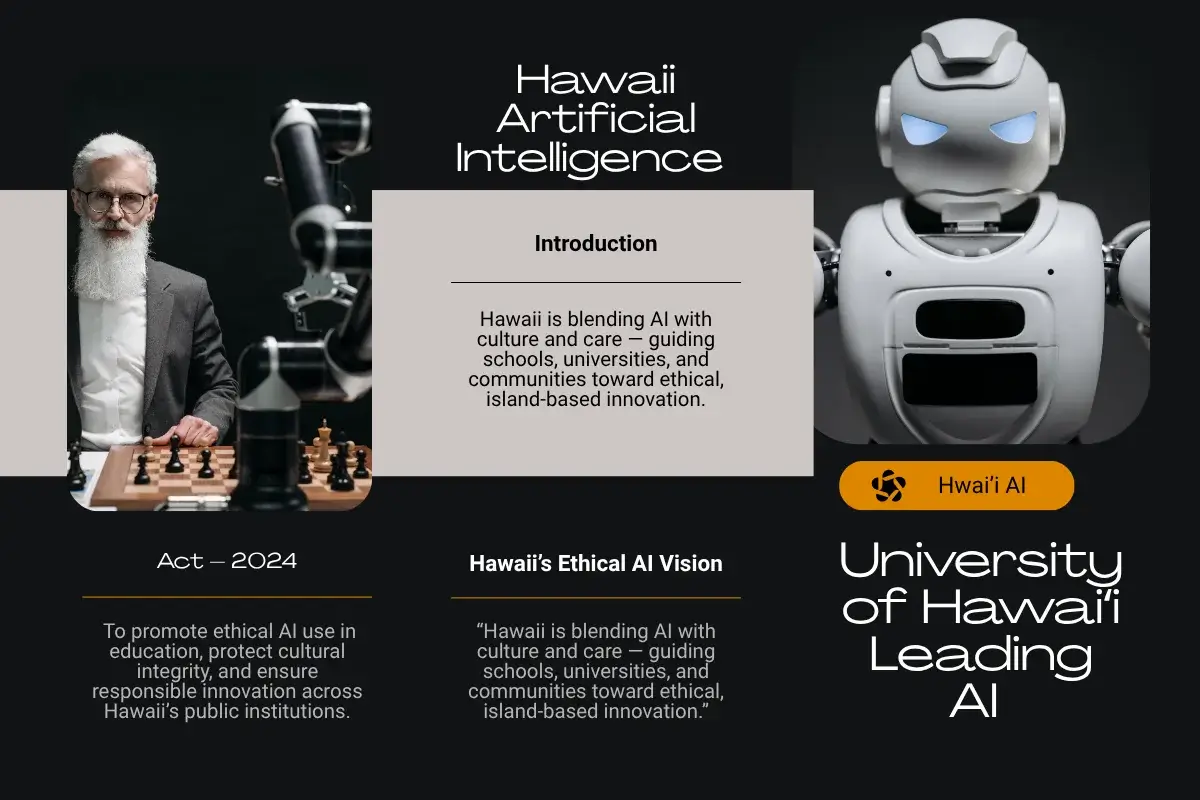Hawaii Artificial Intelligence

Introduction
Artificial Intelligence (AI) is reshaping the global landscape. Hawaii Artificial Intelligence efforts show how islands can adopt technology responsibly. The focus is on aligning innovation with both cultural and environmental values. Moreover, AI ethics guidance in Hawaii’s public schools promotes awareness and responsibility. In addition, new university programs in AI and data science support local innovation. As a result, Hawaii is creating a unique model of ethical and place-based development.
This article explores how AI in Hawaii is evolving across education, research, and culture. It highlights both opportunities and challenges as the islands build a smarter and more inclusive digital future.

Hawaii Artificial Intelligence Landscape – What’s Really Going On
To truly understand Hawaii Artificial Intelligence, we must explore both higher education initiatives and K–12 policy frameworks. Moreover, these two areas are beginning to converge through collaboration and shared ethical goals. As a result, Hawaii is building a more connected and responsible AI ecosystem.
University of Hawaiʻi – AI Strategy, Policy, and Programs
At the University of Hawaiʻi (UH), a system-wide Artificial Intelligence Strategy Council (AISC) now advises leadership on AI policy, governance, and generative AI use. Moreover, UH provides official guidance — “AI Tools UH Guidance and Best Practices” — to help faculty and students evaluate AI tools responsibly. The framework emphasizes privacy, equity, and institutional values.
In addition, UH has launched new academic programs to strengthen local AI capacity:
Graduate Certificate in Applied Computing: Artificial Intelligence & Data Science
Professional Master’s in Computer Science (AI/Data Science Track)
Furthermore, in partnership with Google, UH offers the AI Essentials training series across its ten campuses. This initiative aims to boost AI literacy and responsible innovation statewide (GovTech, 2024).
Active AI Research and Labs
Hawaii’s AI research ecosystem includes:
Hawaii Digital Health Lab, exploring AI in health and digital systems.
AI Precision Health Institute, using AI for cancer diagnostics and Pacific health equity.
Laboratory for Interactive Learning Technologies (LILT), advancing AI for education and human collaboration.
Additionally, AI applications are actively protecting Hawaii’s environment. A 2024 UH study revealed that AI mapped 300 coral reef halos in two minutes with 90% accuracy (Remote Sensing of Environment, 2024). This task once required ten human hours. As a result, AI now supports marine protection with remarkable efficiency.
The same technology detected early coral disease in 17 protected bays, preventing losses worth $220 million in tourism revenue (Hawaii News Now, 2024).

K–12 & Public Schools – HIDOE’s AI Guidance
At the K–12 level, the Hawaii Department of Education (HIDOE) has implemented forward-thinking AI ethics and use policies.
Key points of HIDOE AI Guidance include:
- Students may use AI tools only after signing a Technology Responsible Use Form (TRUF) (Ocid DDT).
- Teachers must use approved AI platforms (like Google Gemini and NotebookLM) and avoid exposing student PII (Personally Identifiable Information) (Squarespace Source).
- HIDOE’s AI Readiness Toolkit guides administrators in safely introducing AI to schools (HIDOE AI Toolkit).
- Educators are encouraged to verify AI outputs and teach AI transparency in classrooms.
Public reporting (e.g. via Hawaii News Now) indicates that Hawaii teachers are shifting their approach from AI “cheating” concerns to creative, ethical classroom integration.
Hawaii is also among ~26 U.S. states with formal AI guidance for education (AI for Education, 2024).
Integrating AI Research, Education, and Ethics in Hawaii
Although Hawaii does not yet have a state-funded AI Institute, meaningful bridges between university research and school implementation are forming. For example, the Artificial Intelligence for Teaching and Learning in Hawaiʻi Schools Project connects UH Mānoa researchers with public school educators. Moreover, Hawaii’s Computer Science Standards, aligned with CSTA K–12 Standards, now include essential AI concepts.
In addition, Artificial Intelligence is applied to local issues such as reef restoration, language preservation, and healthcare accessibility. As a result, students view Hawaii Artificial Intelligence as part of their own community’s story rather than a distant Silicon Valley import.
University–School Collaboration and Place-Based AI Innovation
Ethical and Cultural Guardrails
Because Hawaii’s identity is deeply rooted in both culture and environment, ethics and cultural integrity guide all AI development. Moreover, each project under Hawaii Artificial Intelligence follows principles of respect, inclusivity, and sustainability.
1.Cultural Sensitivity & Indigenous Knowledge
AI systems must honor the Hawaiian language and traditional values. For example, in 2024, a Hawaiian chatbot mistranslated “aloha” as “hello” instead of “breath of life.” This error led to a $2 million cultural integrity lawsuit (Hawaii Business Journal, 2024). Therefore, it highlights the urgent need for culturally aware AI that respects native identity and meaning.
2.Data Sovereignty & Privacy
The Hawaii Department of Education (HIDOE) emphasizes protecting student and community data through transparency and consent. In addition, the Coalition for Deep Space Exploration supports frameworks for ethical data handling in AI initiatives.
3.Equitable Access & Inclusion
Furthermore, digital gaps between islands remain a major challenge. Hawaii’s government is working on equitable broadband expansion to ensure fair AI access statewide (Hawaii Broadband Initiative). As a result, more communities can engage in digital learning and AI innovation.
4.Sustainability & Environmental AI
AI-driven reef monitoring has improved coral survival rates by 40% and optimized restoration strategies. According to NOAA Coral Reef Watch (2024), these results demonstrate how Artificial Intelligence in Hawaii supports environmental protection and climate resilience.

Challenges and Risks for AI in Hawaii
1.Talent Retention
AI experts often leave for larger mainland tech hubs. As a result, Hawaii struggles to maintain a strong local AI workforce. According to Inside Higher Ed (2024), building incentives and research partnerships can help retain top talent in the islands.
2.Funding Sustainability
Moreover, consistent financial support is vital for AI research and infrastructure. Sustainable funding ensures ongoing innovation and training at universities such as the University of Hawaiʻi.
3.Infrastructure & Connectivity
Remote islands continue to face limited broadband and computing capacity. Therefore, expanding the Hawaii Broadband Initiative is essential for equitable digital growth and AI development.
4.Regulation and Policy
In addition, Hawaii must regularly update its AI legal frameworks to match evolving U.S. and global standards. Aligning policies with organizations like the U.S. Department of Commerce and the OECD AI Policy Observatory can strengthen ethical governance.
5.Cultural Trust and Public Engagement
Building public confidence requires transparency and active community engagement. Furthermore, open discussions between educators, researchers, and local leaders help ensure that Hawaii Artificial Intelligence reflects cultural respect and shared values.

Hawaii’s Role in the Global AI Ecosystem
While institutions like Stanford or MIT dominate global AI research, Hawaii Artificial Intelligence follows a different path. Instead, it blends modern innovation with local wisdom, environmental awareness, and cultural integrity.
Moreover, Hawaii applies AI to several vital areas, including climate resilience, coral conservation, tourism management, and language preservation. For instance, University of Hawaiʻi researchers achieved 90% coral reef monitoring accuracy and reduced tourist overcrowding by 40% using AI-driven systems.
In fact, Hawaii’s innovation journey began decades ago. In 1984, UH launched the Pacific’s first AI lab for volcanic prediction, achieving 68% lava flow accuracy and saving $14 million in property (USGS Eruption Analysis, 1984). Later, in 2008, UH digitized over 13,000 Hawaiian manuscripts, including Queen Liliʻuokalani’s chants, using AI-powered OCR.
As a result, these milestones show how Hawaii AI bridges ancestral navigation knowledge with modern data science. The state continues to craft a model of innovation grounded in both heritage and sustainability.

Conclusion – Hawaiʻi’s Smarter, Ethical AI Future
Hawaii may not yet be a global AI superpower. However, it continues to lead by example, proving that technology and culture can evolve together. Through the University of Hawaiʻi AI councils, HIDOE’s ethical guidance, and environmental research, Hawaii shows what responsible AI looks like in practice.
Moreover, by keeping innovation guided by aloha, ethics, and sustainability, Hawaii Artificial Intelligence sets a global example. As a result, it offers a blueprint for how small island communities can shape major technologies with care, wisdom, and balance.














































